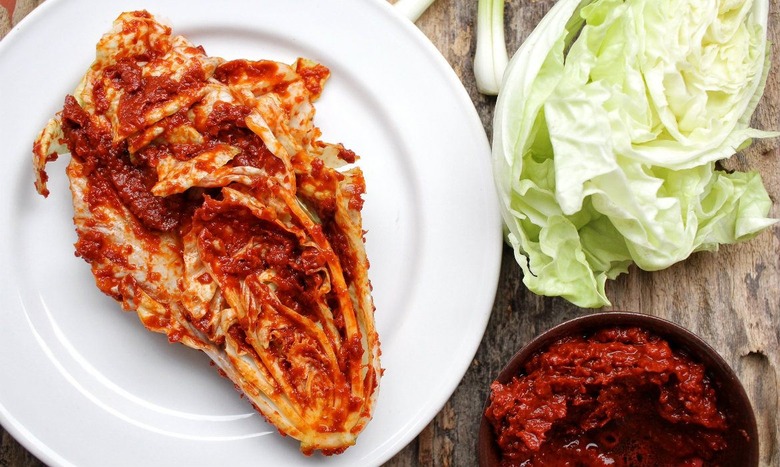Baechu Kimchi (Napa Cabbage Kimchi)
Baechu Kimchi (Napa Cabbage Kimchi)
Napa cabbage: The granddaddy of all kimchi. This is the kimchi that people think of when they hear the word kimchi—from taco topper to the cooler case at Ralph’s. There are literally thousands of different kimchi recipes and combinations, tied to the seasons. That said, this recipe is special.Traditionally, napa kimchi is made in the late autumn (October through December) to prepare for the famously harsh Korean winter. The tradition is called kimjang, and back in the day entire communities got together to make it in large batches. We’re talking as much as 100 heads of cabbage at at time, with recipes passed down village to village, generation to generation. But you can certainly make yourself a batch any time during the year if you can find plump and healthy napa cabbage.Buying the cabbage. Look for cabbage that appears healthy and fresh; remove the outer few layers of leaves if anything is browned. At Korean markets, the peeling away of blighted leaves is often done right in the store. The remaining leaves should be tightly packed.The paste and marinade. Next make the rice flour paste (an important binder) and the marinade, which includes an essential ingredient: salted fermented shrimp called saeujeot. While many recipes callfor fish sauce, we feel the salted shrimp add a pronounced flavor that is just too good to omit. Once combined with the cabbage (don’t forget to wear gloves!) and stuffed into glass jars or plastic containers of varying sizes, the waiting game begins.Kimchi is alive and always changing. Kimchi is all about personal taste, and some like their kimchi fresh, while others like it older and funkier. Our general suggestion is to make a large batch (like 6 to 8 heads) and store it in several jars to sample after different time periods. But if you’re new to the kimchi making process, start small with the recipe here and scale up later. After 5 days, pull out a small jar and eat it wrapped in lettuce with a hunk of grilled Kalbi. After 10 days, pull another jar and place on the table with Godeungeo Gui. Keep one in the back of your refrigerator for two months and stew it down in a Kimchi Jjigae. Or, at any age, just snack on it directly from the jar. Give a jar to your best friend or boss or favorite food fan. This is a serious stocking stuffer. Recipe courtesy of Stuart Brioza.Reprinted from Koreatown: A Cookbook. Copyright © 2016 by Deuki Hong and Matt Rodbard. Photographs copyright © 2016 by Sam Horine. Published by Clarkson Potter, an imprint of Penguin Random House, LLC.

Ingredients
- 12 cup water
- 1 cup coarse sea salt
- 1 large napa cabbage (2 to 3 pounds)
- 2 tablespoon sweet rice flour
- 1 cup water
- 1 small onion, roughly chopped
- 1/2 cup roughly chopped, peeled asian pear
- 2 -inch knob of ginger, roughly chopped
- 6 garlic cloves, minced
- 4 korean red chile peppers, trimmed and cut in half
- 1/4 cup water
- 1/2 cup salted fermented shrimp
- 1/4 cup sugar
- 1/2 cup rice flour paste
- 1 cup coarsely ground gochugaru
- 1 bunch scallions, green parts only, thinly sliced
- 1 carrot, grated
- 1/2 cup peeled and grated daikon radish
Directions
- In a large container, combine 12 cups of cold water and the sea salt. Cut the napa cabbage head lengthwise, then into quarters. Place in the salt water and brine for 6 hours at room temperature. The brining step both adds flavor and opens the cabbage’s pores, allowing the marinade to soak in. Rinse in cold water and have a little bite. If you would prefer it saltier, brine for another 6 hours to overnight; it’s a matter of personal preference.
- Once the cabbage is brined, make the rice flour paste. In a small saucepan over medium-high heat, continually whisk the sweet rice flour and 1 cup water until it reaches a boil. Keep whisking for 2 minutes until it reaches a pudding-like consistency. Remove from heat, transfer to a container and refrigerate until cool.
- Combine the onion, Asian pear, ginger, garlic, chile peppers and ¼ cup water in a food processor and run until smooth, then transfer to a large bowl. Add the shrimp, sugar, rice flour paste, gochugaru, scallion greens, carrot and daikon and combine well.
- Drain the brined cabbage, rinse each piece well in cold water and place them in a very large bowl. While wearing plastic gloves, toss the cabbage with the marinade, coating well. Transfer to clean, large glass jars or clean plastic containers with lids that fit snugly. You can cut the cabbage to fit if you want, or keep the leaves whole and pack them tightly in the jars. Affix the lids, though not too tightly, and place the jars in a cool, dark and dry space and allow to ferment for 1 day.
- Heads up: The fermentation process may cause some kimchi juice to bubble over, so place the jars in a plastic bag. When done, refrigerate for 5 to 7 days, or until the kimchi has reached your desired level of funk. It will keep up to a month in the refrigerator to enjoy eaten directly from the container, or longer for use in further cooking, like in Kimchi Jeon and Kimchi Jjigae.